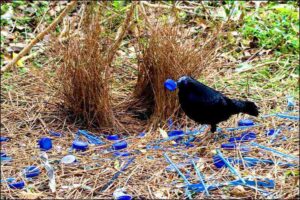By Dr. Beth Leermakers
Chocolate-covered strawberries. Red roses. Slow dancing in the living room. Romance is in the air as Valentine’s Day approaches. Although it’s unclear whether they feel love, some animals display similar behaviors to attract a mate. Like men, many animals will go to great lengths to impress women.

Photo courtesy of Nature
Do animals love? Maybe. Studies show that some animals have the capability to love. In adolescent and adult humans, a chemical called oxytocin activates when someone has a strong attraction to another person. Oxytocin — aka the bonding hormone — is fundamental to human love. Some animals — dogs, cats, goats and some rodents — also have oxytocin.
Whether or not they feel love, many animals engage in elaborate courtship rituals:
Gifts from the Heart
Feed her or be eaten. The male nursery web spider wraps an insect in silk and presents the tasty morsel to a female spider. While she’s enjoying and being distracted by her gift, the male mates with her. When he can’t find an insect, the male spider may gift wrap an inedible object such as a pebble. The female spider accepts the present, but she’ll attack when she unwraps it and discovers the substitution, so the male has to act quickly. Danish researchers discovered that male nursery web spiders give edible gifts to avoid becoming a snack themselves. They found that when the males showed up without a gift, they were eaten 15 percent of the time, compared to just 3.6 percent of the time for gift-bearing males, and it didn’t matter how hungry the female was.
Better than mace. The male ornate moth gives his mate a “nuptial gift.” Ornate moth caterpillars absorb alkaloids (noxious chemicals) from the rattlebox host plant and use them as chemical weapons to defend themselves. When they’re disturbed, ornate moths produce a foaming discharge of alkaloids. Males give some of these defensive chemicals to the females during mating, allowing them to pass the practical gift on to her offspring.
Elaborate Displays
Renaissance men show off their man caves. Male bowerbirds design and build elaborate bowers (bachelor pads) — tunnel-like towers of sticks leading to a “display court” (a stage made of large leaves or tiled with rocks). The males decorate their bower with natural materials (twigs, grass) and sparkly man-made objects to attract females. Different species are drawn to different colors. The male satin bowerbirds decorate their stick towers only with blue objects, including bits of ribbon or plastic. If the female likes his blue nuptial bower, she will visit the male, be entertained by a song or dance on his court, and decide if he is worthy.
Bower quality appears to influence female mating preferences. Studies have shown that female bowerbirds prefer males with well-constructed, highly-decorated bowers. The construction of bowers appears to have evolved to give females information about the relative quality of males.
Male Great bowerbirds are magicians as well as builders and artists. They arrange the objects in their bower to create Illusions, manipulating females’ perceptions and increasing the male’s chances of being chosen as their mate. Their bower is a twig tunnel forming an avenue that opens onto a court with bones, shells and stones on the floor. When a potential mate enters the avenue, the male stands in the court, showing her the colorful objects he’s collected.
The males arrange the objects covering the floor according to size, giving female visitors the impression that all the objects in the court are the same size. As a result, she may perceive the court as being smaller than it really is, and the male to be bigger than he is. This increases the male’s chances of being selected.
Dancing kings strut their stuff. In the spring (breeding season), up to 70 greater sage grouse males gather on traditional dancing grounds to compete for the females’ attention. The males start their courtship display by gulping a gallon of air, inflating yellow-green air sacs on their chest and then forcing the air out. They can spend hours displaying their spiky tail feathers, puffing out their chests and making a popping noise as the air sacs are deflated. Females visit the display ground to mate with one of the males. The oldest, most experienced males (usually chosen by females) jockey for coveted positions at the center of the display ground.
This Valentine’s Day, ladies should be grateful that human romantic gestures are more tasteful. Enjoy those chocolates and be glad you weren’t given silk-wrapped insects.
Happy Valentine’s Day!
